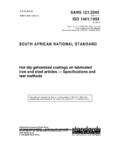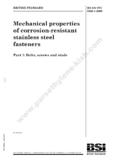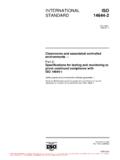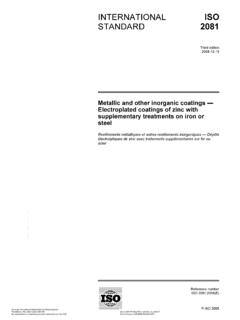Transcription of INTERNATIONAL ISO STANDARD 898-2 - fpg-co.com
1 INTERNATIONAL ISO. STANDARD 898-2 . Third edition 2012-03-15. Mechanical properties of fasteners made of carbon steel and alloy steel . Part 2: Nuts with specified property classes . Coarse thread and fine pitch thread Caract ristiques m caniques des l ments de fixation en acier au carbone et en acier alli . Partie 2: crous de classes de qualit sp cifi es Filetages pas gros et filetages pas fin Reference number ISO 898-2 :2012(E). ISO 2012. ISO 898-2 :2012(E). COPYRIGHT PROTECTED DOCUMENT. ISO 2012. All rights reserved. Unless otherwise specified, no part of this publication may be reproduced or utilized in any form or by any means, electronic or mechanical, including photocopying and microfilm, without permission in writing from either ISO at the address below or ISO's member body in the country of the requester. ISO copyright office Case postale 56 CH-1211 Geneva 20. Tel. + 41 22 749 01 11. Fax + 41 22 749 09 47. E-mail Web Published in Switzerland ii ISO 2012 All rights reserved ISO 898-2 :2012(E).
2 Contents Page iv 1 1. 2 Normative 2. 3 2. 4 Designation 2. Designation of nut 2. Designation of property 2. Ranges of nominal diameters in relation to nut style and property 3. 5 Design of bolt and nut 3. 6 4. 7 Mechanical 5. 8 8. Manufacturer's 8. Supplier's 8. Purchaser's 8. 9 Test 9. Proof load 9. Hardness 11. Surface integrity 13. 10 13. 13. Identification mark of the 13. Marking of property 13. 14. Marking of left-hand 15. Marking of 15. Annex A (informative) Design principles of 16. Annex B (informative) Thread dimensions for the test 19. 21. ISO 2012 All rights reserved iii ISO 898-2 :2012(E). foreword ISO (the INTERNATIONAL Organization for Standardization) is a worldwide federation of national standards bodies (ISO member bodies). The work of preparing INTERNATIONAL standards is normally carried out through ISO. technical committees. Each member body interested in a subject for which a technical committee has been established has the right to be represented on that committee.
3 INTERNATIONAL organizations, governmental and non-governmental, in liaison with ISO, also take part in the work. ISO collaborates closely with the INTERNATIONAL Electrotechnical Commission (IEC) on all matters of electrotechnical standardization. INTERNATIONAL standards are drafted in accordance with the rules given in the ISO/IEC Directives, Part 2. The main task of technical committees is to prepare INTERNATIONAL standards . Draft INTERNATIONAL standards adopted by the technical committees are circulated to the member bodies for voting. Publication as an INTERNATIONAL STANDARD requires approval by at least 75 % of the member bodies casting a vote. Attention is drawn to the possibility that some of the elements of this document may be the subject of patent rights. ISO shall not be held responsible for identifying any or all such patent rights. ISO 898 2 was prepared by Technical Committee ISO/TC 2, Fasteners, Subcommittee SC 12, Fasteners with metric internal thread.
4 This third edition cancels and replaces the second edition (ISO 898 2:1992) and ISO 898-6:1994, which have been technically revised. ISO 898 consists of the following parts, under the general title Mechanical properties of fasteners made of carbon steel and alloy steel: Part 1: Bolts, screws and studs with specified property classes Coarse thread and fine pitch thread Part 2: Nuts with specified property classes Coarse thread and fine pitch thread Part 5: Set screws and similar threaded fasteners with specified hardness classes Coarse thread and fine pitch thread Part 7: Torsional test and minimum torques for bolts and screws with nominal diameters 1 mm to 10 mm1). 1) It is intended that, upon revision, the main element of the title of Part 7 will be aligned with the main element of the title of Part 1. iv ISO 2012 All rights reserved INTERNATIONAL STANDARD ISO 898-2 :2012(E). Mechanical properties of fasteners made of carbon steel and alloy steel.
5 Part 2: Nuts with specified property classes Coarse thread and fine pitch thread 1 Scope This part of ISO 898 specifies mechanical and physical properties of nuts with coarse thread and fine pitch thread made of carbon steel and alloy steel when tested at an ambient temperature range of 10 C to 35 C. Nuts conforming to the requirements of this part of ISO 898 are evaluated at that ambient temperature range. It is possible that they do not retain the specified mechanical and physical properties at elevated and/or lower temperatures. NOTE 1 Nuts conforming to the requirements of this part of ISO 898 have been used in applications ranging from 50 C to +150 C. It is the responsibility of users to consult an experienced fastener materials expert for temperatures outside the range of 50 C to +150 C and up to a maximum temperature of +300 C to determine appropriate choices for a given application. NOTE 2 Information for the selection and application of steels for use at lower and elevated temperatures is given for instance in EN 10269, ASTM F2281 and in ASTM A320/A320M.
6 This part of ISO 898 is applicable to nuts: a) made of carbon steel or alloy steel;. b) with coarse thread M5 D M39, and fine pitch thread M8 1 D M39 3;. c) with triangular ISO metric thread according to ISO 68-1;. d) with diameter/pitch combinations according to ISO 261 and ISO 262;. e) with specified property classes, including proof load;. f) with different nut styles: thin nuts, regular nuts and high nuts;. g) with minimum height m 0,45D;. h) with a minimum outside diameter or width across flats s 1,45D (see Annex A);. i) able to mate with bolts, screws and studs with property classes according to ISO 898-1. For hot dip galvanized nuts, see ISO 10684. This part of ISO 898 does not specify requirements for properties such as: prevailing torque properties (see ISO 2320);. torque/clamp force properties (see ISO 16047 for test method);. weldability;. corrosion resistance. ISO 2012 All rights reserved 1. ISO 898-2 :2012(E). 2 Normative references The following referenced documents are indispensable for the application of this document.
7 For dated references, only the edition cited applies. For undated references, the latest edition of the referenced document (including any amendments) applies. ISO 6157-2, Fasteners Surface discontinuities Part 2: Nuts ISO 6506-1, Metallic materials Brinell hardness test Part 1: Test method ISO 6507-1, Metallic materials Vickers hardness test Part 1: Test method ISO 6508-1, Metallic materials Rockwell hardness test Part 1: Test method (scales A, B, C, D, E, F, G, H, K, N, T). ISO 6892-1, Metallic materials Tensile testing Part 1: Method of test at room temperature ISO 7500 1, Metallic materials Verification of static uniaxial testing machines Part 1: Tension/compression testing machines Verification and calibration of the force-measuring system ISO 16426, Fasteners Quality assurance system 3 Symbols For the purposes of this document, the following symbols apply. D nominal thread diameter of the nut, in millimetres d h hole diameter of the grip, in millimetres F load, in newtons h thickness of the grip, in millimetres m height of the nut, in millimetres P pitch of the thread, in millimetres s width across flats, in millimetres 4 Designation systems Designation of nut styles This part of ISO 898 specifies requirements for three styles of nuts according to their height: style 2: high nut with minimum height mmin 0,9D or mmin > 0,9D; see Table.
8 Style 1: regular nut with minimum height mmin 0,8D; see Table ;. style 0: thin nut with minimum height 0,45D mmin < 0,8D. Designation of property classes General The marking and labelling of nuts with property classes shall be as specified in Clause 10 for only those nuts which meet all applicable requirements of this part of ISO 898. 2 ISO 2012 All rights reserved ISO 898-2 :2012(E). Regular nuts (style 1) and high nuts (style 2). The symbol for property classes of regular nuts (style 1) and high nuts (style 2) consists of one number. It corresponds to the number to the left of the appropriate maximum property class of bolts, screws and studs with which they can be mated. Thin nuts (style 0). The symbol for property classes of thin nuts (style 0) consists of two numbers, specified in the following ways: a) the first number is zero, indicating that the loadability of the nut is reduced in comparison with the loadability of a regular nut or a high nut according to and therefore thread stripping can occur when overloaded.
9 B) the second number corresponds to 1/100 of the nominal stress under proof load on a hardened test mandrel, in megapascals. Ranges of nominal diameters in relation to nut style and property class The ranges of nominal diameters in relation to nut style and property class are as given in Table 1. Table 1 Ranges of nominal diameters in relation to nut style and property class Property class Range of nominal diameters, D. Regular nut (style 1) High nut (style 2) Thin nut (style 0). M5 D M39. 04 . M8 1 D M39 3. M5 D M39. 05 . M8 1 D M39 3. M5 D M39. 5 . M8 1 D M39 3. M5 D M39. 6 . M8 1 D M39 3. M5 D M39 M5 < D M39. 8 . M8 1 D M39 3 M8 1 D M39 3. 9 M5 D M39 . M5 D M39 M5 D M39. 10 . M8 1 D M16 1,5 M8 1 D M39 3. M5 D M39. 12 M5 D M16 . M8 1 D M16 1,5. 5 Design of bolt and nut assemblies Explanations of basic design principles of nuts and loadability of bolted assemblies are given in Annex A. Regular nuts (style 1) and high nuts (style 2) shall be mated with externally threaded fasteners according to Table 2.
10 However, nuts of a higher property class may replace nuts of a lower property class. ISO 2012 All rights reserved 3. ISO 898-2 :2012(E). Table 2 Combination of regular nuts (style 1) and high nuts (style 2) with bolt property classes Maximum property class of mating Nut property class bolt, screw and stud 5 6 8 9 10 12 A decrease of thread stripping strength occurs for nuts with a fundamental deviation greater than zero for tolerance class 6H (such as hot dip galvanized nuts: 6AZ, 6AX). Thin nuts (style 0) have a reduced loadability compared to regular nuts or high nuts, and are not designed to provide resistance to thread stripping. Thin nuts used as jam nuts should be assembled together with a regular nut or a high nut. In assemblies with jam nut, the thin nut is first tightened against the assembled parts and then the regular or high nut is tightened against the thin nut. 6 Materials Table 3 specifies materials and heat treatment for the different property classes of nuts.







